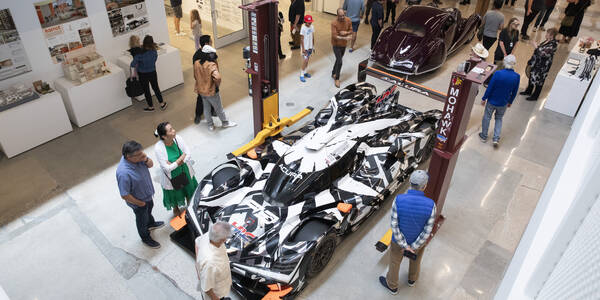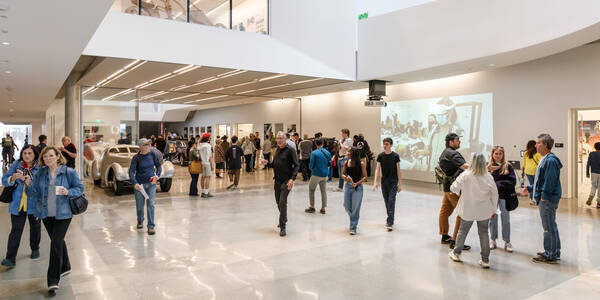
feature / alumni / faculty / transportation-design
August 22, 2024
By Solvej Schou
Oilstainlab founders Iliya and Nikita Bridan bring retro boldness to car design
The twin brothers and Transportation Design alumni and faculty power up with their Half11 race car
“Where the past overtakes the future.” That’s the tagline of car manufacturing and design startup Oilstainlab, founded in 2019 by Transportation Design alumni and Associate Professors Iliya (BS 11) and Nikita Bridan (BS 11).
The Signal Hill-based company’s Half11 prototype race car, designed by the twin brothers, is a vision of orange and white sleekness that encompasses that spirit. With a handmade custom aluminum body, it was inspired by a doodle that Iliya Bridan—who currently also works as a senior manager of vehicle design management at EV company Canoo—created in 2017 of an F1 car from the early ‘70s attached to the front end of a Porshe 911.
The brothers recently showcased the car, which took several years to make, at 2024’s the Quail, a Motorsports Gathering. The event takes place during California’s annual Monterey Car Week, which ArtCenter has participated in for 22 years.
“The Half11 is a love letter to 1960s motor racing,” says Nikita Bridan in a busy Monterey café with his brother, via Zoom. “It was dangerous back then, and we wanted to make a car where there was a responsibility—a gravitas—when you get into it. How do you make a tribute to that era, and do it in your own way? That was the challenge.”
I suggest gaining experience in an industry that you're going to try and disrupt, because you don't know what you don't know.
Nikita BridanOilstainlab co-founder and CEO

Leaning into their retro fantasy, the brothers started creating a fake history for the vehicle, with images of the car in mock historic photos.
“As car designers, you're always designing 10 to 15 years into the future, anticipating new technology, trends, societal movements,” says Nikita Bridan. “The Half11 was our way to escape that and put ourselves into the ’60s. It’s a sci-fi time machine for us. It’s all just one mad dream.”
Born in Ukraine, Iliya and Nikita Bridan moved with their parents to Canada—via Turkey—when they were 3. They loved art and design from a young age, and watched the original Star Wars trilogy, and other science fiction movies, on repeat. They were around 8 when “the car bug bit,” says Nikita Bridan, when their father bought a new car, an SUV.
“That's when we discovered that car design was a thing, and we started drawing cars more intently,” he adds. “Our parents didn't necessarily want us to be car designers. They saw it as a risky career path. They sacrificed so much, as immigrants, and were like, ‘Why don't you just be a lawyer or a doctor?’ But they did support us.”
Their mother, a trained naval architect with a PhD in wave theory, and their father, a businessman who began doing trade overseas, initially worked various jobs when they came to Canada, says Iliya Bridan. “Our mom is very book smart, very intelligent,” he says.
When the family moved from the city to the countryside, the brothers left private school and joined a rural school. At the school, they took an aptitude test, and scored on a 12th grade level. So their parents decided to homeschool them in an accelerated program. At age 14, they took the SATs and scored high enough to apply to colleges.

The brothers attended a design college in Torino, Italy, at age 15, for a year and a half, and settled there with their parents. It was there in Torino that influential automobile designer Frank Stephenson (BS 86 Transportation Design), known for his work for Ford, BMW, Mini, Ferrari and Maserati, told them to go to ArtCenter, says Nikita Bridan. They moved back to Canada, built a portfolio, applied to ArtCenter, and started at the College when they were 17.
As students, the brothers were influenced by faculty member and now current Transportation Design Chair Marek Djordjević, who they did an independent study with. “He took us under his wing, and has been a mentor figure for us,” says Nikita Bridan, who cites his senior thesis project, a Bugatti nuclear concept car, as his favorite project. “I did a fake history for it, and poured my heart and soul into it,” he says. As a student, he interned at Volkswagen.
For Iliya Bridan, going to ArtCenter with his twin brother and working with him has been a profound experience.
“As a twin, you're never lonely, and you always have your best friend there, through thick or thin, which is different than most relationships,” he says. “If you don't want to take that leap of faith, there's someone next to you ready to push you. You always feel like part of a team.”
After graduating, Iliya and Nikita Bridan stayed in Southern California and launched their careers in automotive design, working as advanced designers at Calty Design Research. Iliya Bridan went on to work at Honda R&D Americas, GAC R&D and Canoo. Nikita Bridan’s jobs include having worked at Honda, Hyundai and General Motors.

The pair originally conceived of Oilstainlab in 2012, then postponed pursuing it because they didn’t have green cards at the time. After devoting themselves to their careers, getting green cards, and starting to teach at ArtCenter beginning in 2013, they officially founded Oilstainlab as an art collective, and then a design consultancy, primarily automotive-based, in 2019. They’ve built cars for fashion brands, worked on race cars, and created pitches for vehicles for movie reboots. Nikita Bridan is now fully focused on Oilstainlab as its CEO.
After making Oilstainlab’s Half11 race car prototype, the pair has been designing and engineering the company’s first production vehicle, the HF-11, for the past few years.
“We’ve been moving into the stage of becoming a small batch vehicle manufacturer,” says Iliya Bridan. “This next car, the HF-11, is taking the Half11 and evolving it 60 years, using cutting edge manufacturing materials.”
“It’s going to be substantially more modern, with more creature comforts,” he continues, pointing out that unlike the Half11, the new HF-11 will have massive doors and air conditioning. “It’s a more palatable futuristic version of the original prototype vehicle.”
As ArtCenter faculty members, the brothers taught Transportation Design courses together for a decade, and now teach separately. Iliya Bridan teaches Visual 5, on sophisticated rendering techniques, and Nikita Bridan teaches Visual 4, on descriptive automotive sketching.

Iliya Bridan’s favorite part of teaching, he says, is the reward he gets working one-on-one with students during a term. “Their work starts to grow exponentially,” he says. “It’s great to see students get better and better, as they push through their own comfort zones and barriers.” For Nikita Bridan, students’ career paths are also a reward. “It’s always cool to see some of our students move into design director positions,” he says. “There’s so much talent at ArtCenter.”
When it comes to students having entrepreneurial aspirations, like they did, both Iliya and Nikita Bridan have solid advice.
“Especially in transportation design, you have the privilege of working for very large companies with a lot of resources,” says Iliya Bridan. “There's so much to learn at these companies that it would be a shame to not go through that experience. If you start your own company, always look around you and see where you can learn the most, the fastest, and where you can fail. Because success is one thing, but failure teaches you five times as fast. Fail fast, learn faster.”
Nikita Bridan agrees with his brother.
“I would suggest gaining experience in an industry that you're going to try and disrupt, because you don't know what you don't know,” he says. “When students tell me, ‘I’m going to start my own design consultancy,’ I say, ‘You might want to get a little more experience.’ But again, it's never too early to learn what it takes. Forms, taxes, fees, how to get clients, all those skills. I don't think we could do what we do without 10 years of experience, success and failure.”




